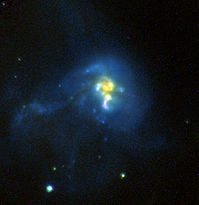
Luminous infrared galaxy
Encyclopedia

Galaxy
A galaxy is a massive, gravitationally bound system that consists of stars and stellar remnants, an interstellar medium of gas and dust, and an important but poorly understood component tentatively dubbed dark matter. The word galaxy is derived from the Greek galaxias , literally "milky", a...
whose defining characteristic is in emitting more than 1011 solar luminosities in the far-infrared
Far infrared astronomy
Far-infrared astronomy is the branch of astronomy and astrophysics that deals with objects visible in far-infrared radiation ....
part of the electromagnetic spectrum. A more luminous system, emitting more than 1012 solar luminosities in the far-infrared, is called ultraluminous infrared galaxy (ULIRG). An even more luminous system, emitting more than 1013 solar luminosities in the far-infrared, is called hyperluminous infrared galaxy (HLIRG). Most LIRGs and ULIRGs emit at least 90% of their light in the infrared
Infrared
Infrared light is electromagnetic radiation with a wavelength longer than that of visible light, measured from the nominal edge of visible red light at 0.74 micrometres , and extending conventionally to 300 µm...
.
Most LIRGs and all ULIRGs show signs of recent or continuing interactions and disruptions. Many are starburst galaxies, and some also contain an active galactic nucleus
Active galactic nucleus
An active galactic nucleus is a compact region at the centre of a galaxy that has a much higher than normal luminosity over at least some portion, and possibly all, of the electromagnetic spectrum. Such excess emission has been observed in the radio, infrared, optical, ultra-violet, X-ray and...
. On average, ULIRGs spawn about 100 new stars yearly, as compared to our own galaxy which spawns one new star a year. ULIRGs are implicated in a variety of interesting astrophysical phenomena including the formation of quasar
Quasar
A quasi-stellar radio source is a very energetic and distant active galactic nucleus. Quasars are extremely luminous and were first identified as being high redshift sources of electromagnetic energy, including radio waves and visible light, that were point-like, similar to stars, rather than...
s and elliptical galaxies
Elliptical galaxy
An elliptical galaxy is a galaxy having an approximately ellipsoidal shape and a smooth, nearly featureless brightness profile. They range in shape from nearly spherical to highly flat and in size from hundreds of millions to over one trillion stars...
. Local examples of ULIRGs are often used as analogs of galaxy formation
Galaxy formation and evolution
The study of galaxy formation and evolution is concerned with the processes that formed a heterogeneous universe from a homogeneous beginning, the formation of the first galaxies, the way galaxies change over time, and the processes that have generated the variety of structures observed in nearby...
at high redshift. ULIRGs seem to be embedded in dark matter halo
Dark matter halo
A dark matter halo is a hypothetical component of a galaxy, which extends beyond the edge of the visible galaxy and dominates the total mass. Since they consist of dark matter, halos cannot be observed directly, but their existence is inferred through their effects on the motions of stars and gas...
with masses of around 10 trillion solar mass
Solar mass
The solar mass , , is a standard unit of mass in astronomy, used to indicate the masses of other stars and galaxies...
es.
External links
- Nearby Extreme Galaxies Linked To Humble Roots (SkyNightly) Jun 07, 2006
- How To Bake A Galaxy (SpaceDaily) Jun 19, 2006
- The Great Observatory All-sky LIRG Survey
See also
- II Zw 96 - a luminous infrared galaxy containing young powerful starburst regions.
- NGC 6240NGC 6240NGC 6240 is a well-studied nearby ultraluminous infrared galaxy in the constellation Ophiuchus. The galaxy is the remnant of a merger between two smaller galaxies...
- a luminous infrared galaxy with two nuclei. - Arp 220Arp 220Arp 220 is the result of a collision between two galaxies which are now in the process of merging. Located 250 million light-years away in the constellation Serpens, it is the 220th object in Halton Arp's Atlas of Peculiar Galaxies.-Features:...
- the closest known ultraluminous infrared galaxy.

